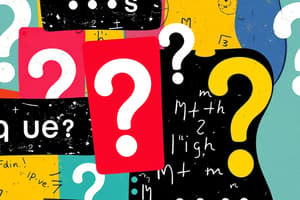Podcast
Questions and Answers
What is the primary purpose of question tags in a statement?
What is the primary purpose of question tags in a statement?
- To change the meaning of the statement
- To express doubt or uncertainty (correct)
- To add more words to the sentence
- To emphasize the main clause
How does the formality level affect the use of question tags?
How does the formality level affect the use of question tags?
- Formal language uses full sentences with proper punctuation (correct)
- The formality level has no impact on question tags
- The formality level only affects regional dialects
- Formal language uses interjections and incomplete utterances
Which factor affects tag placement when using question tags?
Which factor affects tag placement when using question tags?
- The length of the main clause
- Regional dialects
- Social distance between speakers (correct)
- Temperature outside
In which scenario would a question tag typically be used?
In which scenario would a question tag typically be used?
What does the basic structure of a question tag consist of?
What does the basic structure of a question tag consist of?
Which of the following is NOT a common purpose for using question tags?
Which of the following is NOT a common purpose for using question tags?
Which aspect is important to consider before adding a question tag to a statement?
Which aspect is important to consider before adding a question tag to a statement?
What should be kept in mind regarding the word order when using question tags?
What should be kept in mind regarding the word order when using question tags?
How does adding question tags help in communication?
How does adding question tags help in communication?
What is a tip for effectively using question tags in conversations?
What is a tip for effectively using question tags in conversations?
Why is identifying the main verb crucial before adding a question tag?
Why is identifying the main verb crucial before adding a question tag?
Flashcards are hidden until you start studying
Study Notes
Question Tags
Question tags are auxiliary verbs added to the end of statements to make them into questions. These small phrases serve several purposes in adding focus and certainty to a sentence without altering its structure significantly. In the UK, this type of question is called a tag question because it can be attached to almost any statement like a tag.
Grammatical Structure
The basic structure of a question tag consists of two parts: a main clause and an auxiliary verb followed by a subject pronoun. For example, "You're eating chocolate cake, aren't you?". This structure allows the speaker to express doubt or uncertainty while maintaining the original emphasis of the main clause.
Factors Affecting Tag Placement
Tag placement depends on various factors such as the formality level, politeness, and social distance between the speakers. While more formal language uses full sentences with proper punctuation, less formal speech often includes interjections and incomplete utterances. Additionally, the use of tag questions can vary based on cultural norms and regional dialects.
Examples of Question Tags
Here are some examples of how question tags can be used in different contexts:
- Polite request: "You wouldn't happen to have a pen, would you?"
- Statement turning into a question: "It's quite cold today, isn't it?"
- Reason for a decision: "She dropped out of school last year, didn't she?"
- Emphasizing knowledge: "He must be kidding, isn't he?"
- Recalling information: "We met her last week, didn't we?"
In each case, the question tag adds clarity and nuance to the overall message without changing the core meaning of the statement.
Usage Tips
When using question tags, there are a few tips to keep in mind:
-
Identify the main verb of the sentence before adding the tag.
- Example: "They seem happy, don't they?" vs. "They didn't pay me back yet, did they?"
-
Remember the word order of the tag.
- Example: "I thought you were coming tonight, didn't you?" vs. "Didn't you think I was coming tonight?"
-
Avoid combining too many question tags in one sentence.
- Example: "You weren't listening to your music now, weren't you?" could be rephrased as "Were you really ignoring your music just now?"
By following these guidelines, you can effectively use question tags to clarify your communication and engage in natural conversations.
Studying That Suits You
Use AI to generate personalized quizzes and flashcards to suit your learning preferences.




